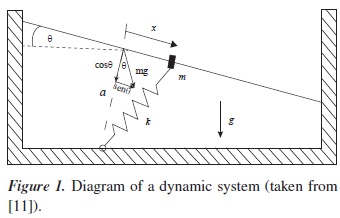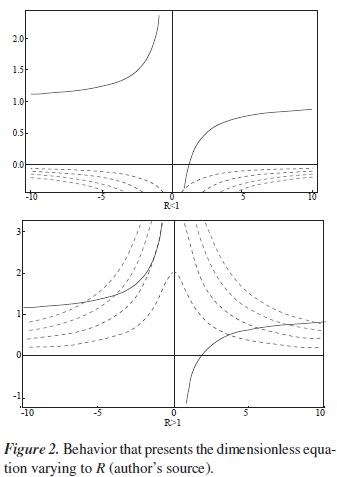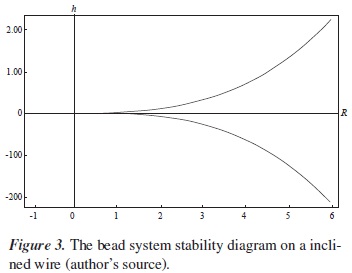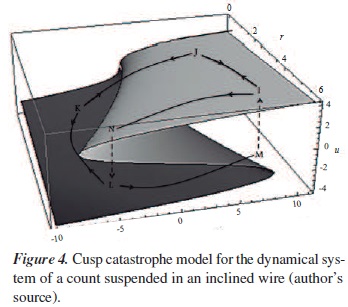Services on Demand
Journal
Article
Indicators
-
 Cited by SciELO
Cited by SciELO -
 Access statistics
Access statistics
Related links
-
 Cited by Google
Cited by Google -
 Similars in
SciELO
Similars in
SciELO -
 Similars in Google
Similars in Google
Share
Ciencia en Desarrollo
Print version ISSN 0121-7488
Ciencia en Desarrollo vol.6 no.1 Tunja Jan./June 2015
Simplified Model of the Catastrophe Theory for the Landslides Study
Modelo simplificado de la teoría de la catástrofe para estudiar los derrumbes
S. L. Castillo Dazaa,*
F. Naranjo Mayorgab
aUniversidad Rural de Pernambuco, Brasil.
*Autor de correspondencia: saralucia.08@gmail.com.
bGroup Theoretical Physics and Computational, Universidad Pedagógica y Tecnológica de Colombia, Tunja, Boyaca, Colombia.
1This is a problem that was proposed by Strogatz in [11] chapter 3, section 3.6.5.
Abstract
I many real world problems the symmetries of the system are only an approximation; the parameters involved in those systems generate an imperfection, where different bifurcation types converge, leading to critical situations called catastrophes.
In the dynamic model of a bead on a wire in a inclined and suspended position, the system represents a catastrophic, condition that to be studied and analyzed, was necessary to use the bifurcation and catastrophe's theories1. The results can be compared with the real world, by the landslide qualitative model, caused by a winter situation.
Key words: Bifurcatio Theory, Catastrophe Theory, Dynamic Systems, Fixed Points, Non-Linear, Stability.
Resumen
En muchos problemas del mundo real, las simetrías del sistema son solo una aproximación; los parámetros involucrados en tales sistemas generan una imperfección, en la cual convergen diferentes tipos de bifurcación, conduciendo a situaciones críticas, denominadas catástrofes. En el modelo dinámico de una cuenta sobre un alambre en posición inclinada y suspendida, el sistema representa una condición catastrófica, que para estudiarse y analizarse fue necesario utilizar las teorías de la bifurcación y las catástrofes. Los resultados pueden compararse con el mundo real, mediante el modelo cualitativo del derrumbe, causado por una situación de invierno.
Palabras clave: Teoría de la bifurcación, Teoría de la catástrofe, Sistemas dinámicos, Puntos fijos, No lineal, Estabilidad.
1. Introduction
I the study of a dynamic bifurcation system, the changes in the behavior that arise from the variations of a given system, are classified [1,2,3]. The qualitative nature that represent the solutions, depend on the parameters that appear in this [2], leading to drastic changes that allow the application of the catastrophe theory, which was originated by the French mathematician René Thom's work in the early seventies [4,5,6] and it is regarded as a topological theory, that even if do not provides quantitative descriptions and predictions, does provide some qualitative descriptions and predictions, based on the space geometries, that do not have a specific magnitude, neither a certain scale [7,8,9].
The catastrophe theory also deals with irregularities and breakdowns, which are appropriate in a system analysis, where the only observation available are the discontinuities generated by the parameters involved in the system's variations [2,10], as in the case of a wire suspended in a straight line, with a deternined inclination angle, that depending on some parameters controled variations, can altered the equilibrium state of the system, causing a sudden abrupt change, that produces a catastrophe, that resembles a landslide in a real system. The catastrophe's study is carried out, from a cusp catastrophe model, corresponding to the seven elementary types of René Thom catastrophes [4,6,11,12].
2. Dynamic Model of a Bead Suspended and Sliding on a Tilted Wire
The system consists of a mass m bead, suspended on a straight inclined wire, which is forced to slide at a θ angle with respect to the horizontal. The bead is attached to a spring of a κ constant elasticity and and a L0 length, and it is actuated by the force of gravity.
Coordinates are chosen along the wire, so that x=0 to the nearest reference point with respect to the spring support point. This variable represents the bead's path around its equilibrium point. The distance between the spring support point and the wire is designated with the letter a, that corresponds to another variable of the system (check Figure 1).
The equation of motion describing the equilibrium position is given by,
L is the hypotenuse obtained from the sum of catheti x and a. When the wire is horizontal (i.e θ = 0 ), there is a perfect symmetry between the left and right sides of the wire and x=0 is always an equilibrium position. If θ ≠ to 0, there may be a considerable inclination which causes the bead balance to suddenly disappear , making it to slide downhill.
3. Results and Discussion
To analyze the stability of the system is used the bifurcations theory [2,3,11] and the catastrophe theory and by a comfort way of working with the dimensionless representation equation (1), which takes the following form:
When
By plotting both sides of the equation (2) gives the behavior that presents the existing fixed points in the system, Figure 2.
For the R<1 values, there is only one balance point, which is unstable and may disappear when the h values get close to R.
For R>1 there are seven equilibrium points which are taken from the intersections generated by the two graphs union, which generates the right side, while the left side generates the equation (2), which disappears if its value is greater than the R values.
On the other hand, in Figure 2 shows that two curves intersect in the case R>1, which indicates that it has a Saddle-node bifurcation [2,3,11]. Such bifurcation curves are given by:
and plot the bifurcation curves observed behavior is obtained in the Figure 3, in which there is a point where the two curves joined tangentially, and the cusp-point corresponds to the point of the system, which arises at the point approximately Rh= (0,−1) and as more R curves diverge, the stable equilibrium points are located around the cusp-point but not in this.
Now to make the system qualitative analysis seen in a three dimensional graph, it is needed to find a form of equation (2) for small r, h, u. So, for convenience we make r = R −1 and to expand it by the neglected Taylor higher order terms, obtaining the following equation:
that by associating it, with the Thom's elementary catastrophe, resembles the cusp catastrophe [12] by having two control parameters r,hand a variable state u. Therefore to graph the equation (5) which has the characteristic form of the cusp catastrophe [5,6,12] (check Figure 4), the surface folded projection corresponds to that observed in Figure 3, which means that the bifurcation curves of equation (4) are the bifurcation set of the catastrophe.
In Figure 4, the trajectory JI, increases the values of the parameters h and r, running from I to N, where N finds it hard to move to L, consequently h presents a small increment which allows the jump from N to L. This abrupt transition from one state to another becomes the catastrophe, which in this case leads to the system collapse.
This means that taking into account the system dimensional variables (h in equation (3)), we know that when working with large values of the bead mass m, and the small elasticity constant κ, the spring elasticity limit tendency, is prone to be exceeded, due to the increasing amount of mass it tends to support. In turn, the parameter value R, that corresponds to the spring length L0, is prone to reach a peak that causes the wire to slide downhill. The same happens if the angle θ that belongs to the parameter h too large, then a significant inclination appears, allowing an increasing friction force generated in the bead, with respect to the wire missing magnitude, causing the sliding.
So that if we refer to a real system, such as a slope ground on which a greater inclination or more land without friction force and cohesion, its presence, sooner or later should produce a slide, called a natural catastrophe, which occurs due to the discontinuity and the abrupt change in the system dynamic components and structure.
In order to study the real system, there should be generated a simulation, in which beads are superimposed on a grid (since we work with only one particle, or not many) to simulate the slipping, also there should be introduced some real parameters related to the theoretical model, such as: The moisture that had to do with the friction and cohesion intensity, the grain type or size concerns about the mass of each count, the field adhesion properties, which correspond to the spring elasticity constant κ and the model inclination angle, that should have to see, with the inclination angle of the slope.
On the other side, one can produce another catastrophe, when M try to get to I, because at this point, it is produced a sudden jump from one state to another, but in this case the r and h values decrease. The cycle generated by I,N,L,M,I in Figure 4 is called hysteresis [10].
4. Conclusions
A system number of fixed points or equilibrium, depends on the parameters involved variation, since their appearance or disappearance causes, lead to a saddle-node type bifurcation.
The trajectories designated in Figure 4, allow to comprise a physically system dynamics and its critical point, so when occurs any sudden changes or jumps on it, they become a catastrophic event, as they alter its equilibrium state, regarding the system original dimensional variables.
The presence of events as disturbances or falls in a system originate significant changes, which leads to abrupt changes called catastrophes [13], which depends on certain controled parameters, that their occurrence can lead to the system collapse, as observed in the model of the bead on the bent wire, or it may happen on a hill or slope of a mountain, where some parameters such as humidity, soil type and the slope of the ground, tend to vary considerably and suddenly causing landslides, with some significant damage.
The Catastrophe Theory provides some and a language to build a model, that offers an insight into a system developing dynamics, taking into account the transitions discontinuously, with their sudden jumps and changes, so it could be used to analyze other situations or disciplines such as, heartbeats, prison riots, embryology, experimental psychology, economics, geology and hydrodynamics.
References
[1] R. Carballo Rubio. "Dinámica no Lineal, [online]. Disponible en: http:rcarballo.es/page8.php. [ Links ]
[2] J. B. Moreno, "Simulación cualitativa sobre diagramas de bifurcación, Tésis de Maestría, Dep. Ciencias en Ingeniería Eléctrica, Universidad Michoacana de San Nicolás de Hidalgo México, 2008. Capítulo 2. [ Links ]
[3] M. Ramírez Loaiza. "Diseño y simulación de un criptosistema caótico para comunicaciones seguras", Tesis Licenciatura, Ingeniería en Electrónica y comunicaciones, Departamento de Computación, Electrónica, Física e Innovación, Escuela de Ingeniería y Ciencias, Universidad de las Américas, Puebléxico. Mayo. Derechos Reservados 2006. Capítulo 3. [ Links ]
[4] R. Thom. "Física Aristotélica y Teoría de las Catástrofes", Barcelona: Gedisa, 1990. [ Links ]
[5] E. Zeeman. "Catastrofe theory", Scientific American, pp. 65-70, 75-83, april, 1976. [ Links ]
[6] R. Bulajich, R. E. Martínez. "Teoría de Catástrofes", Ciencias, vol. 20, pp. 4-10, octubre, 1990. [ Links ]
[7] R. Gilmore. Catastrophe Theory for Scientists and Engineers, New York: Wiley, 1981. [ Links ]
[8] V. I. Arnol'd. "Catastrophe Theory", segunda edición, Springer-Verlag, Berlin, Heidelberg, 1984. [ Links ]
[9] T. Poston, I. N. Stewart. Catastrophe Theory and Its Applications, London: Pitman, 1978. [ Links ]
[10] V. J. Martin. "La teoría de catástrofes y la geografía: Aplicaciones en Climatología", Revista de Geografía vol. XXVII-XXVIII, pp. 21-32. Barcelona 1993-94. [ Links ]
[11] S. H. Strogatz. Nonlinears Dynamics and Chaos with Applications to Physics, Biology, Chemistry and Engineering, Perseus Books Publishing, 1994. [ Links ]
[12] C. Reynoso. Complejidad y Caos: Una exploración antropológica, Universidad de Buenos Aires, 2006. [ Links ]
[13] E. Garza Olguin. Teoría de Catástrofes, Centro Universitario San Ángel. Enero 2010. [ Links ]
[14] J. Anzurez M, J. A. Padilla G, S. O. Cuevas. "Estabilidad de sistemas no-lineales: sistemas de nivel de líquidos de dos tanques interconectados". Revista de Ingeniería Eléctrica, Electrónica y Computacional, vol. 5, no. 2, Diciembre, 2008. [ Links ]






















